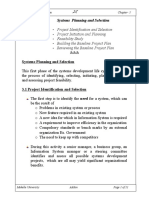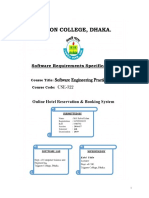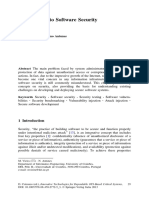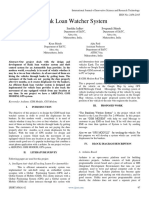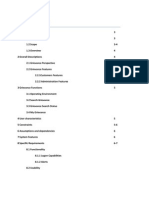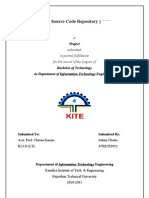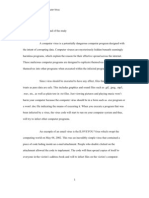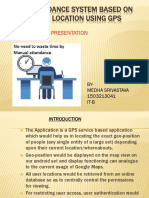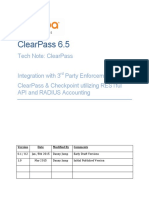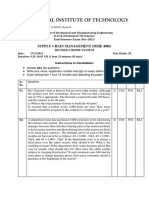Agile Software Development: 5.1 Coping With Change
Agile Software Development: 5.1 Coping With Change
Uploaded by
Bharath KumarCopyright:
Available Formats
Agile Software Development: 5.1 Coping With Change
Agile Software Development: 5.1 Coping With Change
Uploaded by
Bharath KumarOriginal Title
Copyright
Available Formats
Share this document
Did you find this document useful?
Is this content inappropriate?
Copyright:
Available Formats
Agile Software Development: 5.1 Coping With Change
Agile Software Development: 5.1 Coping With Change
Uploaded by
Bharath KumarCopyright:
Available Formats
download from vtuloop.
com
Software Engineering [15CS42]
5. AGILE SOFTWARE DEVELOPMENT
5.1 Coping with Change
The system requirements change as the business procuring the system responds to
external pressures and management priorities change.
Change adds to the costs of software development because it usually means that work
that has been completed has to be redone. This is called rework.
There are two related approaches that may be used to reduce the costs of rework:
1. Change avoidance, where the software process includes activities that can
anticipate possible changes before significant rework is required. For example,
a prototype system may be developed to show some key features of the system
to customers. They can experiment with the prototype and refine their
requirements before committing to high software production costs.
2. Change tolerance, where the process is designed so that changes can be
accommodated at relatively low cost. This normally involves some form of
incremental development.
There are 2 ways of coping with change and changing system requirements
1. System prototyping, where a version of the system or part of the system is
developed quickly to check the customer’s requirements and the feasibility of
some design decisions. This supports change avoidance as it allows users to
experiment with the system before delivery and so refine their requirements.
2. Incremental delivery, where system increments are delivered to the customer
for comment and experimentation. This supports both change avoidance and
change tolerance. It avoids the premature commitment to requirements for the
whole system and allows changes to be incorporated into later increments at
relatively low cost.
5.1.1 Prototyping
A prototype is an initial version of a software system that is used to demonstrate
concepts, try out design options, and find out more about the problem and its possible
solutions.
A software prototype can be used in a software development process to help
anticipate changes that may be required:
Prof. Mamatha E, Asst. Prof., Dept. of ISE, SVIT, Bengaluru Page 1
download from vtuloop.com
Software Engineering [15CS42]
1. In the requirements engineering process, a prototype can help with the
elicitation and validation of system requirements.
2. In the system design process, a prototype can be used to explore particular
software solutions and to support user interface design.
System prototypes allow users to see how well the system supports their work.
They may get new ideas for requirements, and find areas of strength and weakness in
the software. They may then propose new system requirements.
A system prototype may be used while the system is being designed to carry out
design experiments to check the feasibility of a proposed design.
For example, a database design may be prototyped and tested to check that it supports
efficient data access for the most common user queries.
A process model for prototype development is shown in fig 5.1.
Fig 5.1: The process of prototype development
The objectives of prototyping should be made explicit from the start of the process.
These may be to develop a system to prototype the user interface, to develop a system
to validate functional system requirements, or to develop a system to demonstrate the
feasibility of the application to managers.
The next stage in the process is to decide what to put into and, perhaps more
importantly, what to leave out of the prototype system.
The final stage of the process is prototype evaluation.
Developers are sometimes pressured by managers to deliver throwaway prototypes,
particularly when there are delays in delivering the final version of the software.
However, this is usually unwise:
1. It may be impossible to tune the prototype to meet non-functional
requirements, such as performance, security, robustness, and reliability
requirements, which were ignore during prototype development.
Prof. Mamatha E, Asst. Prof., Dept. of ISE, SVIT, Bengaluru Page 2
download from vtuloop.com
Software Engineering [15CS42]
2. Rapid change during development inevitably means that the prototype is
undocumented. The only design specification is the prototype code. This is not
good enough for long-term maintenance.
3. The changes made during prototype development will probably have degraded
the system structure. The system will be difficult and expensive to maintain.
4. Organizational quality standards are normally relaxed for prototype
development
5.1.2 Incremental Delivery
Incremental delivery (Fig 5.2) is an approach to software development where some of
the developed increments are delivered to the customer and deployed for use in an
operational environment. In an incremental delivery process, customers identify, in
outline, the services to be provided by the system.
Fig 5.2: Incremental delivery
They identify which of the services are most important and which are least important
to them.
Once the system increments have been identified, the requirements for the services to
be delivered in the first increment are defined in detail and that increment is
developed.
During development, further requirements analysis for later increments can take place
but requirements changes for the current increment are not accepted.
Incremental delivery has a number of advantages:
1. Customers can use the early increments as prototypes and gain experience that
informs their requirements for later system increments. Unlike prototypes,
these are part of the real system so there is no re-learning when the complete
system is available.
Prof. Mamatha E, Asst. Prof., Dept. of ISE, SVIT, Bengaluru Page 3
download from vtuloop.com
Software Engineering [15CS42]
2. Customers do not have to wait until the entire system is delivered before they
can gain value from it. The first increment satisfies their most critical
requirements so they can use the software immediately.
3. The process maintains the benefits of incremental development in that it
should be relatively easy to incorporate changes into the system.
4. As the highest-priority services are delivered first and increments then
integrated, the most important system services receive the most testing. This
means that customers are less likely to encounter software failures in the most
important parts of the system.
However, there are problems with incremental delivery:
1. Most systems require a set of basic facilities that are used by different parts of
the system. As requirements are not defined in detail until an increment is to
be implemented, it can be hard to identify common facilities that are needed
by all increments.
2. Iterative development can also be difficult when a replacement system is being
developed. Users want all of the functionality of the old system and are often
unwilling to experiment with an incomplete new system. Therefore, getting
useful customer feedback is difficult.
3. In the incremental approach, there is no complete system specification until
the final increment is specified. This requires a new form of contract, which
large customers such as government agencies may find difficult to
accommodate.
5.2 Plan-driven and Agile Development
Agile approaches to software development consider design and implementation to be
the central activities in the software process.
They incorporate other activities, such as requirements elicitation and testing, into
design and implementation.
In a plan-driven approach, iteration occurs within activities with formal documents
used to communicate between stages of the process.
For example, the requirements will evolve and, ultimately, a requirements
specification will be produced.
Prof. Mamatha E, Asst. Prof., Dept. of ISE, SVIT, Bengaluru Page 4
download from vtuloop.com
Software Engineering [15CS42]
This is then an input to the design and implementation process.
In an agile approach, iteration occurs across activities. Therefore, the requirements
and the design are developed together, rather than separately
A plan-driven software process can support incremental development and delivery.
It is perfectly feasible to allocate requirements and plan the design and development
phase as a series of increments.
An agile process is not inevitably code-focused and it may produce some design
documentation.
Fig 5.3 shows the distinctions between plan-driven and agile approaches to system
specification
Fig 5.3: Plan- driven and agile specification
5.3 Extreme Programming
In extreme programming, requirements are expressed as scenarios (called user
stories), which are implemented directly as a series of tasks.
Programmers work in pairs and develop tests for each task before writing the code.
All tests must be successfully executed when new code is integrated into the system.
Fig 5.4 illustrates the XP process to produce an increment of the system that is being
developed.
Prof. Mamatha E, Asst. Prof., Dept. of ISE, SVIT, Bengaluru Page 5
download from vtuloop.com
Software Engineering [15CS42]
Fig 5.4: The extreme programming release cycle
Extreme programming involves a number of practices, summarized in fig 5.5, which
reflect the principles of agile methods:
* Incremental development is supported through small, frequent releases of the
system. Requirements are based on simple customer stories or scenarios that
are used as a basis for deciding what functionality should be included in a
system increment.
* Customer involvement is supported through the continuous engagement of the
customer in the development team. The customer representative takes part in
the development and is responsible for defining acceptance tests for the
system.
* People, not process, are supported through pair programming, collective
ownership of the system code, and a sustainable development process that
does not involve excessively long working hours.
* Change is embraced through regular system releases to customers, test-first
development, refactoring to avoid code degeneration, and continuous
integration of new functionality.
* Maintaining simplicity is supported by constant refactoring that improves code
quality and by using simple designs that do not unnecessarily anticipate future
changes to the system.
Prof. Mamatha E, Asst. Prof., Dept. of ISE, SVIT, Bengaluru Page 6
download from vtuloop.com
Software Engineering [15CS42]
Fig 5.5: Extreme programming practices
5.3.1 Testing in XP
XP includes an approach to testing that reduces the chances of introducing
undiscovered errors into the current version of the system.
The key features of testing in XP are:
* Test-first development,
* Incremental test development from scenarios,
* User involvement in the test development and validation, and
* The use of automated testing frameworks.
Fig 5.6 is a shortened description of a test case that has been developed to check that
the prescribed dose of a drug does not fall outside known safe limits.
Prof. Mamatha E, Asst. Prof., Dept. of ISE, SVIT, Bengaluru Page 7
download from vtuloop.com
Software Engineering [15CS42]
Fig 5.6: Test case description for dose checking
The role of the customer in the testing process is to help develop acceptance tests for
the stories that are to be implemented in the next release of the system.
Test automation is essential for test-first development.
Tests are written as executable components before the task is implemented.
These testing components should be standalone, should simulate the submission of
input to be tested, and should check that the result meets the output specification.
An automated test framework is a system that makes it easy to write executable tests
and submit a set of tests for execution.
Test-first development and automated testing usually results in a large number of tests
being written and executed.
However, this approach does not necessarily lead to thorough program testing.
There are three reasons for this:
1. Programmers prefer programming to testing and sometimes they take
shortcuts when writing tests. For example, they may write incomplete tests
that do not check for all possible exceptions that may occur.
2. Some tests can be very difficult to write incrementally. For example, in a
complex user interface, it is often difficult to write unit tests for the code that
implements the ‘display logic’ and workflow between screens.
3. It’s difficult to judge the completeness of a set of tests. Although there are lot
of system tests, the test set may not provide complete coverage. Crucial parts
of the system may not be executed and so remain untested.
5.3.2 Pair Programming
Another innovative practice that has been introduced in XP is that programmers work
in pairs to develop the software.
Prof. Mamatha E, Asst. Prof., Dept. of ISE, SVIT, Bengaluru Page 8
download from vtuloop.com
Software Engineering [15CS42]
They actually sit together at the same workstation to develop the software.
The use of pair programming has a number of advantages:
* It supports the idea of collective ownership and responsibility for the system.
* It acts as an informal review process because each line of code is looked at by
at least two people. Code inspections and reviews are very successful in
discovering a high percentage of software errors.
* It helps support refactoring, which is a process of software improvement. The
difficulty of implementing this in a normal development environment is that
effort in refactoring is expended for long-term benefit. An individual who
practices refactoring may be judged to be less efficient than one who simply
carries on developing code. Where pair programming and collective
ownership are used, others benefit immediately from the refactoring so they
are likely to support the process.
5.4 Agile Project Management
The principal responsibility of software project managers is to manage the project so
that the software is delivered on time and within the planned budget for the project.
They supervise the work of software engineers and monitor how well the software
development is progressing.
Fig 5.7 is a diagram of the Scrum management process.
Fig 5.7: The Scrum process
Scrum does not prescribe the use of programming practices such as pair programming
and test-first development.
It can therefore be used with more technical agile approaches, such as XP, to provide
a management framework for the project.
There are three phases in Scrum.
Prof. Mamatha E, Asst. Prof., Dept. of ISE, SVIT, Bengaluru Page 9
download from vtuloop.com
Software Engineering [15CS42]
The first is an outline planning phase where you establish the general objectives for
the project and design the software architecture.
This is followed by a series of sprint cycles, where each cycle develops an increment
of the system.
Finally, the project closure phase wraps up the project, completes required
documentation such as system help frames and user manuals, and assesses the lessons
learned from the project.
A Scrum sprint is a planning unit in which the work to be done is assessed, features
are selected for development, and the software is implemented.
At the end of a sprint, the completed functionality is delivered to stakeholders. Key
characteristics of this process are as follows:
1. Sprints are fixed length, normally 2–4 weeks. They correspond to the
development of a release of the system in XP.
2. The starting point for planning is the product backlog, which is the list of work
to be done on the project. During the assessment phase of the sprint, this is
reviewed, and priorities and risks are assigned. The customer is closely
involved in this process and can introduce new requirements or tasks at the
beginning of each sprint.
3. The selection phase involves all of the project team who work with the
customer to select the features and functionality to be developed during the
sprint.
4. Once these are agreed, the team organizes themselves to develop the software.
Short daily meetings involving all team members are held to review progress
and if necessary, reprioritize work.
5. At the end of the sprint, the work done is reviewed and presented to
stakeholders. The next sprint cycle then begins.
Advantages:
* The product is broken down into a set of manageable and understandable
chunks.
* Unstable requirements do not hold up progress.
* The whole team has visibility of everything and consequently team
communication is improved.
Prof. Mamatha E, Asst. Prof., Dept. of ISE, SVIT, Bengaluru Page 10
download from vtuloop.com
Software Engineering [15CS42]
* Customers see on-time delivery of increments and gain feedback on how the
product works.
* Trust between customers and developers is established and a positive culture
is created in which everyone expects the project to succeed.
5.5 Scaling Agile Methods
Agile methods were developed for use by small programming teams who could work
together in the same room and communicate informally.
Agile methods have therefore been mostly used for the development of small and
medium-sized systems.
Large software system development is different from small system development in a
number of ways:
* Large systems are usually collections of separate, communicating systems,
where separate teams develop each system. Frequently, these teams are
working in different places, sometimes in different time zones. It is practically
impossible for each team to have a view of the whole system.
* Large systems are ‘brownfield systems’ that is they include and interact with a
number of existing systems. Many of the system requirements are concerned
with this interaction and so don’t really lend themselves to flexibility and
incremental development
* Where several systems are integrated to create a system, a significant fraction
of the development is concerned with system configuration rather than original
code development. This is not necessarily compatible with incremental
development and frequent system integration.
* Large systems and their development processes are often constrained by
external rules and regulations limiting the way that they can be developed, that
require certain types of system documentation to be produced, etc.
* Large systems have a long procurement and development time. It is difficult to
maintain coherent teams who know about the system over that period as,
inevitably, people move on to other jobs and projects.
* Large systems usually have a diverse set of stakeholders. For example, nurses
and administrators may be the end-users of a medical system but senior
Prof. Mamatha E, Asst. Prof., Dept. of ISE, SVIT, Bengaluru Page 11
download from vtuloop.com
Software Engineering [15CS42]
medical staff, hospital managers, etc. are also stakeholders in the system. It is
practically impossible to involve all of these different stakeholders in the
development process.
There are two perspectives on the scaling of agile methods:
1. A ‘scaling up’ perspective, which is concerned with using these methods for
developing large software systems that cannot be developed by a small team
2. A ‘scaling out’ perspective, which is concerned with how agile methods can
be introduced across a large organization with many years of software
development experience.
It is difficult to introduce agile methods into large companies for a number of reasons:
* Project managers who do not have experience of agile methods may be
reluctant to accept the risk of a new approach, as they do not know how this
will affect their particular projects.
* Large organizations often have quality procedures and standards that all
projects are expected to follow and, because of their bureaucratic nature, these
are likely to be incompatible with agile methods. Sometimes, these are
supported by software tools (e.g., requirements management tools) and the use
of these tools is mandated for all projects.
* Agile methods seem to work best when team members have a relatively high
skill level. However, within large organizations, there are likely to be a wide
range of skills and abilities, and people with lower skill levels may not be
effective team members in agile processes.
* There may be cultural resistance to agile methods, especially in those
organizations that have a long history of using conventional systems
engineering processes
5.6 The Agile manifesto: Values and Principles
Values:
* Individuals and interactions over processes and tools
* Working software over comprehensive documentation
* Customer collaboration over contract negotiation
* Responding to change over following a plan
Prof. Mamatha E, Asst. Prof., Dept. of ISE, SVIT, Bengaluru Page 12
download from vtuloop.com
Software Engineering [15CS42]
Principles:
* Highest priority is to satisfy the customer through early and continuous
delivery of valuable software
* Welcome changing requirements, even late in development. Agile processes
harness change for the customers competitive advantage
* Deliver working software frequently, from a couple of weeks to couple of
months, with a preference to the shortest timescale
* Business people and developers must work together daily throughout the
project.
* Build projects around motivated individuals. Give them the environment and
the support they need, and trust them to get the job done
* The most efficient and effective method of conveying information to and
within a development team is face-to-face conversation
* Working software is the primary measure of progress
* Agile processes promote sustainable development. The sponsors, developers
and users should be able to maintain a constant pace indefinitely
* Continuous attention to technical excellence and good design enhances agility
* Simplicity – the art of maximizing the amount of work not done – is essential
* The best architectures, assignments and designs emerge from self organizing
teams.
* At regular intervals the team reflects on how to become more effective, then
tunes and adjusts its behavior accordingly.
Prof. Mamatha E, Asst. Prof., Dept. of ISE, SVIT, Bengaluru Page 13
You might also like
- StopWatch ReportDocument11 pagesStopWatch ReportGeoffrey Chua0% (1)
- Employee Management System: L. N. Mishra College of Business ManagementDocument56 pagesEmployee Management System: L. N. Mishra College of Business ManagementSaurav ShauryaNo ratings yet
- Internship Presentation PPT SampleDocument14 pagesInternship Presentation PPT SampleMohd Arif KhanNo ratings yet
- Biometric Attendance SystemDocument12 pagesBiometric Attendance Systemchirag suresh chiruNo ratings yet
- 6 Access Layer PDFDocument84 pages6 Access Layer PDFAllen Chandler50% (2)
- Projectreport 121202043850 Phpapp02Document120 pagesProjectreport 121202043850 Phpapp02Narayan LokeNo ratings yet
- Srs Student ManagementdocxDocument16 pagesSrs Student ManagementdocxLevko DovganNo ratings yet
- Project ProposalDocument2 pagesProject ProposalRishNo ratings yet
- U5 AQ5 With AnswersDocument14 pagesU5 AQ5 With Answersshubh agrawalNo ratings yet
- College Connect AppDocument20 pagesCollege Connect AppKeerthi0% (1)
- Chapter 1: Introduction 1.1.2 Internet of Things (Iot) : Basic ConceptDocument29 pagesChapter 1: Introduction 1.1.2 Internet of Things (Iot) : Basic ConceptJpsworldNo ratings yet
- MD Project ReportDocument60 pagesMD Project ReportShankarNo ratings yet
- Enhancing LAN Using CryptographyDocument2 pagesEnhancing LAN Using CryptographyMonim Moni100% (1)
- How To Install Kaspersky Anti-Virus - SoftwareKeepDocument6 pagesHow To Install Kaspersky Anti-Virus - SoftwareKeepMwasamani GundaNo ratings yet
- Online Transaction Fraud Detection Using Backlogging On E-Commerce WebsiteDocument4 pagesOnline Transaction Fraud Detection Using Backlogging On E-Commerce WebsiteSiddique ShahistaNo ratings yet
- Attendance System For Students of Government-Aided SchoolsDocument8 pagesAttendance System For Students of Government-Aided SchoolsIJRASETPublicationsNo ratings yet
- Employee Leave Management System Project ReportDocument91 pagesEmployee Leave Management System Project Report007Ãrnav SinghaNo ratings yet
- Online Polling Sytem Project ReportDocument43 pagesOnline Polling Sytem Project ReportShailesh Prajapati100% (1)
- Dark Mode 3D Illustration Cyber Security PresentationDocument6 pagesDark Mode 3D Illustration Cyber Security PresentationFarrah MekkiNo ratings yet
- Software Requirements Specification (SRS)Document10 pagesSoftware Requirements Specification (SRS)Ali AbdulNo ratings yet
- Micro ProjectDocument22 pagesMicro ProjectSreehari YermalNo ratings yet
- Yvette Ruth 19/06448 Bbit (Ai Project) Town (Campus Full Time)Document5 pagesYvette Ruth 19/06448 Bbit (Ai Project) Town (Campus Full Time)Jäy JâyNo ratings yet
- Secure Data Sharing in Cloud Computing Using Revocable Storage Identity - Based EncryptionDocument4 pagesSecure Data Sharing in Cloud Computing Using Revocable Storage Identity - Based EncryptionEditor IJRITCCNo ratings yet
- Study On E-Waste Management MethodologyDocument5 pagesStudy On E-Waste Management MethodologyIJRASETPublicationsNo ratings yet
- Systems Planning and SelectionDocument11 pagesSystems Planning and SelectionNATI NT100% (1)
- SRS Document For VTOP QueryDocument11 pagesSRS Document For VTOP QueryAyanNo ratings yet
- STE-Micro ProjectDocument15 pagesSTE-Micro ProjectJai MalharNo ratings yet
- SRS - Online Car Rental System 1Document6 pagesSRS - Online Car Rental System 1Prem Sai Reddy PittaNo ratings yet
- Hostel ManagementDocument20 pagesHostel ManagementSahil KumarNo ratings yet
- Hostel Management System PPT OumfboDocument20 pagesHostel Management System PPT OumfboRahul sainiNo ratings yet
- Project Online Mobile Recharge SystemDocument10 pagesProject Online Mobile Recharge SystemJatin Sharma100% (2)
- Face Biometric Authentication System For ATM Using Deep LearningDocument10 pagesFace Biometric Authentication System For ATM Using Deep LearningIJRASETPublicationsNo ratings yet
- Implementation of Iot Based Electricity Controlled Prepaid Energy Meter Monitoring and Bill Payment System IJERTCONV6IS15036Document5 pagesImplementation of Iot Based Electricity Controlled Prepaid Energy Meter Monitoring and Bill Payment System IJERTCONV6IS15036Muhammad AwaisNo ratings yet
- Online Library Management System: Mini Project Report OnDocument30 pagesOnline Library Management System: Mini Project Report OnRavikumar KhilariNo ratings yet
- Unit-1 STQADocument127 pagesUnit-1 STQAavbcNo ratings yet
- Srs - Document - For - Hotel - Management - System Md. Rabiul IslamDocument27 pagesSrs - Document - For - Hotel - Management - System Md. Rabiul IslamRobiul IslamNo ratings yet
- Project Report: Fashion DesigningDocument54 pagesProject Report: Fashion DesigningramprasadsahNo ratings yet
- Introduction To Software Security ConceptsDocument10 pagesIntroduction To Software Security ConceptsDoğukan SarıNo ratings yet
- "Bank Loan Watcher System" 3Document3 pages"Bank Loan Watcher System" 3International Journal of Innovative Science and Research TechnologyNo ratings yet
- Insurance Management System Project ReportDocument41 pagesInsurance Management System Project ReportKamal AcharyaNo ratings yet
- Online Society Tracking: A Project Report OnDocument187 pagesOnline Society Tracking: A Project Report OnمحذNo ratings yet
- Online Hotel Booking System 1Document9 pagesOnline Hotel Booking System 1EESHA AGARWALNo ratings yet
- SRS Grievance CellDocument7 pagesSRS Grievance Celllovely2000No ratings yet
- (Source Code Repository) : ProjectDocument10 pages(Source Code Repository) : ProjectSaurabh SinghNo ratings yet
- Cyber Crime Synopsis PDFDocument6 pagesCyber Crime Synopsis PDFAman0% (1)
- Application Development Using FlutterDocument5 pagesApplication Development Using FlutterDee Pan KarNo ratings yet
- Advanced Car & Scooty Training Driving School Management SystemDocument6 pagesAdvanced Car & Scooty Training Driving School Management SystemVivek LamsNo ratings yet
- ATM Project Report LeesysDocument39 pagesATM Project Report Leesyskapilchoudhary14No ratings yet
- 41 - JAVA - Student Assignment Management SystemDocument6 pages41 - JAVA - Student Assignment Management Systemnational coursesNo ratings yet
- SRS RFID Employee Attendance Tracking System StupendousJSSDocument92 pagesSRS RFID Employee Attendance Tracking System StupendousJSSstupendoustanuj100% (1)
- Network Security and Cryptography: KSR College of EngineeringDocument11 pagesNetwork Security and Cryptography: KSR College of EngineeringAvinash Cool Buddy100% (1)
- Bug Tracking System: Nikunj AggarwalDocument104 pagesBug Tracking System: Nikunj AggarwalAmit KapoorNo ratings yet
- Data Dissemination and Synchronization: Communications Asymmetry, Classification of DataDocument29 pagesData Dissemination and Synchronization: Communications Asymmetry, Classification of DataHarish SarkiNo ratings yet
- Enhancing Data Security in Iot Healthcare Services Using Fog ComputingDocument36 pagesEnhancing Data Security in Iot Healthcare Services Using Fog ComputingMudassir khan MohammedNo ratings yet
- Unit Ii - Project Life Cycle and Effort Estimation 2.1 Software Process and Process ModelsDocument19 pagesUnit Ii - Project Life Cycle and Effort Estimation 2.1 Software Process and Process Models123No ratings yet
- Research PaperDocument12 pagesResearch Paperjoanne_mendoza_1100% (1)
- Software Requirements Specification: Packet Sniffing Using WiresharkDocument8 pagesSoftware Requirements Specification: Packet Sniffing Using WiresharkVishal GuptaNo ratings yet
- Mobile Location Based Attendance SystemDocument19 pagesMobile Location Based Attendance SystemAnonymous q0GrakM8No ratings yet
- Online Footwear Store ProjectDocument31 pagesOnline Footwear Store ProjectRushikesh JagadaleNo ratings yet
- Network Management System A Complete Guide - 2020 EditionFrom EverandNetwork Management System A Complete Guide - 2020 EditionRating: 5 out of 5 stars5/5 (1)
- Technical Data Sheet 1a 6aDocument6 pagesTechnical Data Sheet 1a 6aSidharth MathewNo ratings yet
- 2250 2edDocument9 pages2250 2edkihal zohirNo ratings yet
- Activities Guide and Evaluation Rubric - Unit 2 - Phase 2 - Creation of Materials and StrategiesDocument8 pagesActivities Guide and Evaluation Rubric - Unit 2 - Phase 2 - Creation of Materials and Strategiesjaider gòmez vegaNo ratings yet
- AAHL-Permutation and CombinationDocument4 pagesAAHL-Permutation and CombinationAnkush ChawlaNo ratings yet
- Leading - SAFe - Agilist PDFDocument5 pagesLeading - SAFe - Agilist PDFSree NivasNo ratings yet
- Nitobond EP: Epoxy Resin Concrete Bonding AgentDocument2 pagesNitobond EP: Epoxy Resin Concrete Bonding AgentjitendraNo ratings yet
- AWS C5.1-73 Plasma Arc Welding PDFDocument76 pagesAWS C5.1-73 Plasma Arc Welding PDFkrishnatejanitdgpNo ratings yet
- Travel Winter 14Document84 pagesTravel Winter 14asdfghijklmnñNo ratings yet
- Case Study of An Indigenous Brand - Parle-G: Harish K. RamanDocument15 pagesCase Study of An Indigenous Brand - Parle-G: Harish K. RamanAsheeshMahajanNo ratings yet
- Mivan FormworkDocument25 pagesMivan FormworkSohail ShaikhNo ratings yet
- Easylyte - Electrolyte Analyzer - Medica CorporationDocument1 pageEasylyte - Electrolyte Analyzer - Medica CorporationToshko AndreevNo ratings yet
- Chapter 7 Key TermsDocument6 pagesChapter 7 Key TermsWayneNo ratings yet
- CPPM TechNote - 3rd Party Enforcement Points (CheckPoint) v1Document32 pagesCPPM TechNote - 3rd Party Enforcement Points (CheckPoint) v1eric1107No ratings yet
- DLL - Week1 - PretestDocument2 pagesDLL - Week1 - PretestErica RayosNo ratings yet
- SCC PIW SD PE Taman Salmon SG BulohDocument4 pagesSCC PIW SD PE Taman Salmon SG BulohJohan RamliNo ratings yet
- TCP CenterMass RobotiqDocument3 pagesTCP CenterMass RobotiqTiago Domíngues Veríssimo DuarteNo ratings yet
- NHH 04 My Mother Made Me A HomosexualDocument13 pagesNHH 04 My Mother Made Me A HomosexualPivaNo ratings yet
- Paragraph WritingDocument4 pagesParagraph WritingRana HassanNo ratings yet
- Decorative ConcretesDocument5 pagesDecorative Concretesnaveen kumar pathiNo ratings yet
- Quality Control Batubara Dari Channel-Pit Menuju Stockpile: Pt. Kuasing Inti MakmurDocument10 pagesQuality Control Batubara Dari Channel-Pit Menuju Stockpile: Pt. Kuasing Inti MakmurDiiNo ratings yet
- Supply Chain Management (Mme 4086) : Department of Mechanical and Manufacturing Engineering End-Semester Exam (Dec-2021)Document2 pagesSupply Chain Management (Mme 4086) : Department of Mechanical and Manufacturing Engineering End-Semester Exam (Dec-2021)Arihant GargNo ratings yet
- Bba140 Lecture 3 - Political EnvironmentDocument10 pagesBba140 Lecture 3 - Political Environmentbuman999heingNo ratings yet
- Maintenance AU680Document9 pagesMaintenance AU680Hishamudin RaisNo ratings yet
- Practical Research 2 Group 1Document22 pagesPractical Research 2 Group 1Luis ConcepcionNo ratings yet
- EHI - Competella Communication Suite For Teams Deployment Guide V1.0Document45 pagesEHI - Competella Communication Suite For Teams Deployment Guide V1.0karim.loukiliNo ratings yet
- Report autoDNA WVGZZZ5NZJW874119 PDFDocument5 pagesReport autoDNA WVGZZZ5NZJW874119 PDFMed DecodageNo ratings yet
- Compatibilitate TyresDocument10 pagesCompatibilitate TyresArocoraCababacNo ratings yet
- Echo and NarcissusDocument2 pagesEcho and Narcissusapi-349408035No ratings yet
- 36 Interfacing Adc0808 With Serial Port Rs232 8051 Microcontroller Using Clock From D Flip FlopDocument6 pages36 Interfacing Adc0808 With Serial Port Rs232 8051 Microcontroller Using Clock From D Flip Flopprajapatiprashant40No ratings yet
























